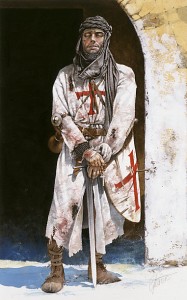I was recently asked which of the two rites of freemasonry common to the American experience I preferred. I gave my response to which the questioner suggested I convert it into a blog post.
![flickr-2200500024-medium[1]](http://www.arslatomorum.com/wp-content/uploads/2011/12/flickr-2200500024-medium1-300x243.jpg)
I don’t see value in contrasting the two common rites of American masonry for the following reasons:
- because the York Rite is anything but;
- it undermines the currents of masonry giving rise to these rites;
- it sets up an unnecessary antagonism between the two.
I prefer to look at currents or schools of Masonry of which I see two dominate currents in the US: the Craft current and the Haut-Grade current (which includes a sub current of Chivalric Masonry).
In an overly generalized way I see degrees breaking down into the currents as such:
Craft: Entered Apprentice, Fellowcraft, Master Mason, Mark Master, Royal Ark Mariner, Installation of the Master/Board of Installed Masters, and the Royal Arch. To a lesser extent I include the Past Master (virtual) and the Most Excellent Master as I see them as solutions to the problems solved in the Installation of the Master and other legalistic problems. Additionally Noachide Masonry more properly belongs in this school, although many Noachide degrees are more greatly developed in the Haut-Grade environment. Such degrees must be weighed and vetted individual before assignment.
Haut-Grade: All degrees of the Ancient and Accepted Scottish Rite, Royal and Select Master, Super Excellent Master, all orders of the Commandery. While many of the ineffable degrees of the AASR contain elements of the Craft current, how we received these degrees is indubitably within the ecossais frame, which according to Mackey distinguishing hallmark of ecossais masonry is the preservation of the Master’s Word, where English craft masonry did not. For practical application, anything deriving of the Scots Master Degree, and/or Ramsay, or largely promulgated from either of the two are of the Haut Grade School.
Direct Answer
So which is a better current of Masonry? It depends on what you are looking for. If you want Craft Masonry, the Lodge and the Chapter will be most satisfying. If you want Haut-Grade Masonry, then, the Scottish Rite, the Council and the Commandery are ideal.
The York Rite has a heavier Craft experience, but contains both Craft and Haut-Grade. The Scottish Rite contains very little of the Craft current, and is fundamentally a Haut-Grade system. Interestingly, while many join the York Rite looking for chivalric masonry, i.e. Templary, and while I maintain the Order of the Temple is still to most beautiful and most intense and most real degree experience I’ve had in Masonry, chivalric masonry is without equivocation (in my mind) a component of the Haut-Grade current and reaches a fuller expression within the Scottish Rite, not the York Rite.
Rambling Answer
To call the York Rite a rite is incorrect. The degrees and orders of the York Rite do not offer a progressively unfolding experience of Masonic initiation.
To be fair, when Étienne Morin assembled his Order of the Royal Secret, he didn’t really create a Rite either. His efforts are better viewed as a “greatest hits album” of Masonic degrees within the Bordeaux region of France. Although his original ‘patent’ gave him authority over the ineffable, or Craft degrees, he was not satisfied with a Craft focus, and this ‘patent’ was modified or his power increased over the sublime (high degrees), where his interests truly resided. He was not unique amongst his French Brothers in this regard. France is the home of Haut-Grade masonry, and Bordeaux was a hot bed for the same.
When Mitchell, Dalcho and Co. established the first Supreme Council in 1801, this situation remained largely unchanged. It wasn’t until Pike’s efforts to rework the Scottish Rite that it became a proper Rite of Freemasonry.
The York Rite however remains largely a greatest hits collection of popularly worked Masonic degrees by itinerant Masonic lecturers. It is a catalog of the American Masonic experience. While some of these have coalesced into bodies, i.e. the Chapter, the Council, and the Commandery, as well as AMD, other invitational and honorary bodies, how a Mason receives these degrees from body to body is not progressive, and sequential experiences within a given body, do not always comment on, or reveal more of, previous experiences. In total, editorial evolution of all the various experiences of the York Rite are not entirely consistent on an agreed movement forward.
With new framework of currents, the question about which is the better Rite is clearly unfair, for the York Rite, isn’t a Rite. The York Rite is a confederation of degree systems, sometimes just a warehouse of degrees looking for a home and for masonic authenticity in the American schema. The new framework allows for a appreciation of the evolution of the Rites, and perhaps the intended goal and meaning of them. And the framework of currents allows us to escape unnecessary brand loyalties, and because we can approach Masonry more as a menu of experiences, we can tailor our individual growth to our individual tastes without antagonism.
So, to truly understand Haut-Grade Masonry within the American milieu, you need both the Scottish Rite, and Cryptic Masonry and the Orders of the Commandery, and several of the side and invitational bodies of the York system (Royal Order of Scotland, much of the higher AMD and SRICF experiences immediately to mind) in this Mason’s opinion. As given in the short answer, this includes Chivalric Masonry, which is a component of Haut-Grade masonry, and has its fullest expressions (for the majority of US masons) in the Scottish Rite, not the Order of the Temple. However, the Order of the Temple experience itself is perhaps the most beautiful individual experience.
If you want Craft masonry, the Council, the Commandery, and the Scottish Rite won’t be nearly as important as the Chapter, and many of the side degrees of the York Rite, such as the Operatives, the Royal Ark Mariner, and other Craft and Noachide elements of AMD and side degrees.
But in all honesty, to be an effective Mason in the 21st century, in the US, I really think you need both. Both currents contain essential expressions of the Initaitic experience in Freemasonry, which to me anyway, is the heart and soul of our brotherhood, and has been since the late 17th and early 18th centuries.
Photo Credit: Colin K.


![flickr-2200500024-medium[1]](http://www.arslatomorum.com/wp-content/uploads/2011/12/flickr-2200500024-medium1-300x243.jpg)